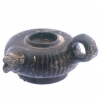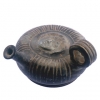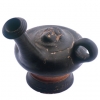|
Ancient Greek
|
|
 |
|
 |
|

Price :
$1200.00
A thick red band encircles the center of this jar, with two very thin lines above, and a slightly thicker one below. The bulbous body widens at the middle then tapers quickly More »
A thick red band encircles the center of this jar, with two very thin lines above, and a slightly thicker one below. The bulbous body widens at the middle then tapers quickly to the narrow base that has a thick red border. An energetic wavy line is the only decoration on the upper portion; particularly attractive set against a buff background. The everted lip is done in red, connected by the handle that curves to middle of the body and is ornamented with a laurel leaf in red. The Greek colonists of Southern Italy (known as Magna Grecia) developed their own style of ceramic ware; a fact vividly evident in this fine vessel - (SP.007) « Less
|
|
Ancient Greek
|
|
|
|
|
| Vendor Details |
Close |
| Contact Info : |
| Barakat Gallery |
| 405 North Rodeo Drive |
| Beverly Hills |
| California-90210 |
| USA |
| Email : barakat@barakatgallery.com |
| Phone : 310.859.8408 |
|
|
|
|
|
|

Price :
$180.00
Origin: Mediterranean Circa: 400 BC to 300 BC Dimensions: 4.5" (11.4cm) high Collection: Classical Style: Magna Graecian Medium: Terracotta
Origin: Mediterranean Circa: 400 BC to 300 BC Dimensions: 4.5" (11.4cm) high Collection: Classical Style: Magna Graecian Medium: Terracotta
« Less
|
|
Ancient Greek
|
|
|
|
|
| Vendor Details |
Close |
| Contact Info : |
| Barakat Gallery |
| 405 North Rodeo Drive |
| Beverly Hills |
| California-90210 |
| USA |
| Email : barakat@barakatgallery.com |
| Phone : 310.859.8408 |
|
|
|
|
|
|

Price :
$2400.00
In the eighth century B.C., Greek settlers left their homeland behind and established a string of colonies along the Adriatic coast of Southern Italy. After the rise of Rome More »
In the eighth century B.C., Greek settlers left their homeland behind and established a string of colonies along the Adriatic coast of Southern Italy. After the rise of Rome centuries later, this region would become known by the Latin term Magna Graecia, literally “Greater Greece,†due to the dense concentration of Greek settlements. The Greeks flourished here alongside the native populations, amassing great wealth through trade and importing their Hellenic culture throughout the area. They in turn were influenced by their neighbors, so that Magna Graecian pottery developed into a unique style that reflected both Greek and native Italian traditions.This squat lekythos is pure in form and simple in decoration. Covered in a luminous black glaze, the only non-functional adornment is the vertical lines incised along the body. In an ancient Greek household, this vessel would have been used to carry and disperse liquids during banquets. - (CK.0042)
« Less
|
|
Ancient Greek
|
|
|
|
|
| Vendor Details |
Close |
| Contact Info : |
| Barakat Gallery |
| 405 North Rodeo Drive |
| Beverly Hills |
| California-90210 |
| USA |
| Email : barakat@barakatgallery.com |
| Phone : 310.859.8408 |
|
|
|
|
|
|

Price :
$6000.00
Origin: Southern Italy Circa: 5 th Century BC to 4 th Century BC Dimensions: 10.5" (26.7cm) high x 9.5" (24.1cm) wide Collection: Classical Style: Magna Graecian Medium: More »
Origin: Southern Italy Circa: 5 th Century BC to 4 th Century BC Dimensions: 10.5" (26.7cm) high x 9.5" (24.1cm) wide Collection: Classical Style: Magna Graecian Medium: Terracotta « Less
|
|
Ancient Greek
|
|
|
|
|
| Vendor Details |
Close |
| Contact Info : |
| Barakat Gallery |
| 405 North Rodeo Drive |
| Beverly Hills |
| California-90210 |
| USA |
| Email : barakat@barakatgallery.com |
| Phone : 310.859.8408 |
|
|
|
|
|
|

Price :
$6500.00
Athena, goddess of wisdom and war, guards this lovely oil lamp filler (called an guttus) arrayed in a most splendid helmet. She was an ingenious deity and credited with the More »
Athena, goddess of wisdom and war, guards this lovely oil lamp filler (called an guttus) arrayed in a most splendid helmet. She was an ingenious deity and credited with the discovery of olive oil, which this vessel may have contained. Her magnificent image was perhaps meant to frighten away evil spirits, and to guarantee that the lamps filled from its spout burned brightly and safely. When we place our finger into the loop handle where ancient hands rested centuries ago, we are caught up in the impressive beauty of the piece, just as the original owners certainly were. - (PF.0079) « Less
|
|
Ancient Greek
|
|
|
|
|
| Vendor Details |
Close |
| Contact Info : |
| Barakat Gallery |
| 405 North Rodeo Drive |
| Beverly Hills |
| California-90210 |
| USA |
| Email : barakat@barakatgallery.com |
| Phone : 310.859.8408 |
|
|
|
|
|
|

Price :
$700.00
In the Classical world, even the most common household object could be touched with elegance and beauty. This charming vessel was used to pour oil into lamps that illuminated More »
In the Classical world, even the most common household object could be touched with elegance and beauty. This charming vessel was used to pour oil into lamps that illuminated wealthy homes during the height of antiquity. The oil was filtered through the central hole, and then poured out through the lion-headed spout. As we place our forefinger through the handle we are aware of ancient hands, forgotten by time, which held it just as we do. We make the gesture of pouring oil into a lamp and suddenly a room, a house, then an entire world comes alive in our imagination. Through such a simple action, we link ourselves intimately to the past. - (PF.0198) « Less
|
|
Ancient Greek
|
|
|
|
|
| Vendor Details |
Close |
| Contact Info : |
| Barakat Gallery |
| 405 North Rodeo Drive |
| Beverly Hills |
| California-90210 |
| USA |
| Email : barakat@barakatgallery.com |
| Phone : 310.859.8408 |
|
|
|
|
|
|

Price :
Contact Dealer
Before the modern advents of trains and automobiles, trade between civilizations concentrated around the Mediterranean moved foremost by sea. While many bulk commodities such More »
Before the modern advents of trains and automobiles, trade between civilizations concentrated around the Mediterranean moved foremost by sea. While many bulk commodities such as timber and stone could be loaded directly aboard a ship with little preparation, other commodities such as spices, wine, and grain needed to be packed in individual containers for transport both at sea and on land and to prolong their lifespan. Pottery was first created in order to fulfill these practical needs. Over time, the art form evolved from large, unadorned commercial transport vessels to refined, specialized works in elegant shapes used to hold precious substances such as perfume or oils.An entire retinue of terracotta vessels dedicated to the rites of the dinner table began to appear. These pieces were based on the luxurious bronze and silver vessels that could only be afforded by the wealthy elite and were decorated with fanciful natural motifs and painted scenes of everyday life and celebrated myths. These wares were of such beauty that they themselves became prized commodities and were traded throughout the Mediterranean world; perhaps even for the very substances they were created to contain. These works are individually classified by their shapes and their form was inherently linked to their function, be it preparation, dispensation, or consumption.One of these specific types, kraters are large bowl-shaped vessels with wide mouths and two handles that stand on footed bases. Foremost among the different types of kraters is the bell krater, so-called because it emits a pleasant ringing sound not unlike a bell when gently struck with a finger. Kraters were an integral piece of equipment used during the symposium, an ancient Greek dinner and drinking banquet immortalized by Plato. Symposia were hosted inside the private residences of the upper classes, held inside a special room complete with a floor that sloped into a central drain to facilitate cleaning the morning after. Music played by hired consorts and highbrow political and philosophical discussions were the main activities; although, as the evening transpired and the effects of the wine took over, more physical pleasure became the true focus. Wine would be diluted with water inside the krater before the mixed concoction would be dispensed to the individual revelers. Kraters were often decorated with painted scenes depicting groups of figures dining and relaxing, activities that paralleled the festivities of the symposia during which the vessels were actually used.
« Less
|
|
Ancient Greek
|
|
|
|
|
| Vendor Details |
Close |
| Contact Info : |
| Barakat Gallery |
| 405 North Rodeo Drive |
| Beverly Hills |
| California-90210 |
| USA |
| Email : barakat@barakatgallery.com |
| Phone : 310.859.8408 |
|
|
|
|
|
|

Price :
$1200.00
A lion's head serves as the spout of this handsome oil lamp. It has a sieve-top for the oil to be filtered through, a flat base, striations on the side and a short handle. More »
A lion's head serves as the spout of this handsome oil lamp. It has a sieve-top for the oil to be filtered through, a flat base, striations on the side and a short handle. This type of pottery flourished in this period, developing into a unique style independent of the Greek mainland. This lamp attests to the skill that the Greek artists possessed, exhibiting a smooth finish and fine detailing. - (PF.5388) « Less
|
|
Ancient Greek
|
|
|
|
|
| Vendor Details |
Close |
| Contact Info : |
| Barakat Gallery |
| 405 North Rodeo Drive |
| Beverly Hills |
| California-90210 |
| USA |
| Email : barakat@barakatgallery.com |
| Phone : 310.859.8408 |
|
|
|
|
|
|

Price :
$2500.00
The typical bulbous shape of the guttus is rather elongated in this particular vessel; though it still has a long spout and short handle characteristic of its type. More »
The typical bulbous shape of the guttus is rather elongated in this particular vessel; though it still has a long spout and short handle characteristic of its type. Horizontal striations around the middle add texture to the smooth black surface. Most likely a vessel for re-filling oil lamps, the guttus is one of the unusual creations of the Greek potters of Southern Italy. Their excellent skills are evident in this fine vessel, which was once a useful household item and today is an interesting artifact. - (PF.5389) « Less
|
|
Ancient Greek
|
|
|
|
|
| Vendor Details |
Close |
| Contact Info : |
| Barakat Gallery |
| 405 North Rodeo Drive |
| Beverly Hills |
| California-90210 |
| USA |
| Email : barakat@barakatgallery.com |
| Phone : 310.859.8408 |
|
|
|
|
|
|

Price :
$2500.00
A Gorgon head ornaments the top of this guttus. Typical of the vessel's unique style it has a very long spout, ridged at the end, and a short handle on the side. The bulbous More »
A Gorgon head ornaments the top of this guttus. Typical of the vessel's unique style it has a very long spout, ridged at the end, and a short handle on the side. The bulbous body has a series of vertical striations around the middle, contrasting to the smooth base that is composed of two sections exposing the orange clay. The very long spout suggests the guttus was used as a filling-vessel for oil lamps, though some scholars have speculated it was intended as a feeding bottle for infants. Certainly functional whatever its original purpose, this vessel offers an example of ancient ingenuity and the ceramic artist's skill. - (PF.5390) « Less
|
|
Ancient Greek
|
|
|
|
|
| Vendor Details |
Close |
| Contact Info : |
| Barakat Gallery |
| 405 North Rodeo Drive |
| Beverly Hills |
| California-90210 |
| USA |
| Email : barakat@barakatgallery.com |
| Phone : 310.859.8408 |
|
|
|
|
|
|
|
|

|


